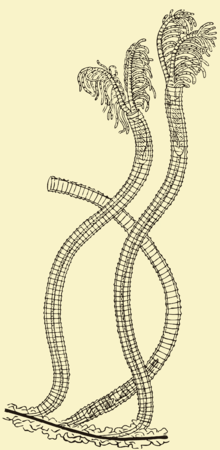Rhabdopleura normani
Rhabdopleura normani is a small, marine species of worm-shaped animal. It is a sessile suspension feeder,[3] lives in clear water, and secretes tubes on the ocean floor.
| Rhabdopleura normani | |
|---|---|
 | |
| Scientific classification | |
| Kingdom: | |
| Phylum: | |
| Class: | |
| Order: | |
| Family: | |
| Genus: | |
| Species: | R. normani |
| Binomial name | |
| Rhabdopleura normani | |
| Synonyms | |
|
Rhabdopleura mirabilis Sars, 1872[2] | |
Description
This species grows in colonies. Each individual achieves a length of 0.5 mm, with a total colony length of approximately 20 mm.[4][5]
Located on the tentacles are lateral, frontal, and frontolateral ciliary bands. These are 8-13 μm in length and composed of cilia. In specimens collected in Bermuda, ciliated perforations were found. These ran down the length of the arms, in particular, between the bases of other tentacles laying adjacent.[3]
Distribution
Rhabdopleura normani is widely distributed along the coastlines of the Bering Sea, Norwegian Sea, Atlantic Ocean, and Mediterranean Sea.[6] It has also been found in Bermuda.
Habitat
This species lives in colonies on the ocean floor. It has been found at depths ranging from 5 m to 896 m, but most commonly occurs between 100 m and 300 m.[7][8]
Feeding
R. normani does not use mucus to capture food. Instead, it uses only a local reversal of a ciliary beat. It is also capable of rejecting unsuitable food particles employing several distinct methods.[3]
Reproduction
Both sexes live together in the colonies. Females have distinctive basally-coiled tubes in which they brood their eggs, each 200 μm in size. As these yolky eggs develop, they cleave radially, and become larvae. These larvae are ciliated, lecithotrophic, and oblong, achieving a length of 400 μm. They can be identified in the following ways:[4]
- They have a yellow coloration, covered with black spots
- A deep ventral depression is present
- There is a posterior adhesive organ and an anterior apical sensory organ
- The epidermis has consistent ciliation
The ventral depression is actually a glandular epithelium, as opposed to invaginating endoderm. The larval cocoon and adult tube are secreted from this depression.[4]
Inside, the peritoneum of the coelomic cavities starts to disconnect from the main mass of the yolky mesenchyme cells. After breaking free, the larva then swims using its cilia.[4]
References
- "Rhabdopleura normani". Sealifebase.org. Retrieved 2011-11-03.
- "WoRMS - World Register of Marine Species - Rhabdopleura normani Allman, 1869". Marinespecies.org. Retrieved 2011-11-03.
- Halanych, K.M. (1993). "Suspension Feeding by the Lophophore-Like Apparatus of the Pterobranch Hemichordate Rhabdopleura normani". Biological Bulletin. 185 (3): 417–427. doi:10.2307/1542482. JSTOR 1542482. PMID 29300629.
- Lester, Susan M. (1987-06-10). "Ultrastructure of Adult Gonads and Development and Structure of the Larva of Rhabdopleura normani (Hemichordata: Pterobranchia)". Acta Zoologica. 69 (2): 95–109. doi:10.1111/j.1463-6395.1988.tb00906.x.
- "LHSVirtualZoo - Rhabdopleura normani". Lhsvirtualzoo.wikispaces.com. 2011-03-17. Retrieved 2011-11-03.
- A.R.D. Stebbin, 1970, The Status And Ecology Of Rhabdopleura Compacta (Hemichordata) From Plymouth, J. mar. biol. Ass. U.K., 50, 209-221, p.210
- http://www.app.pan.pl/archive/published/app16/app16-415.pdf
- http://journals.cambridge.org/download.php?file=%2FMBI%2FMBI50_01%2FS0025315400000722a.pdf&code=edd4e528e5af318eec9cdaa4de02bcf5